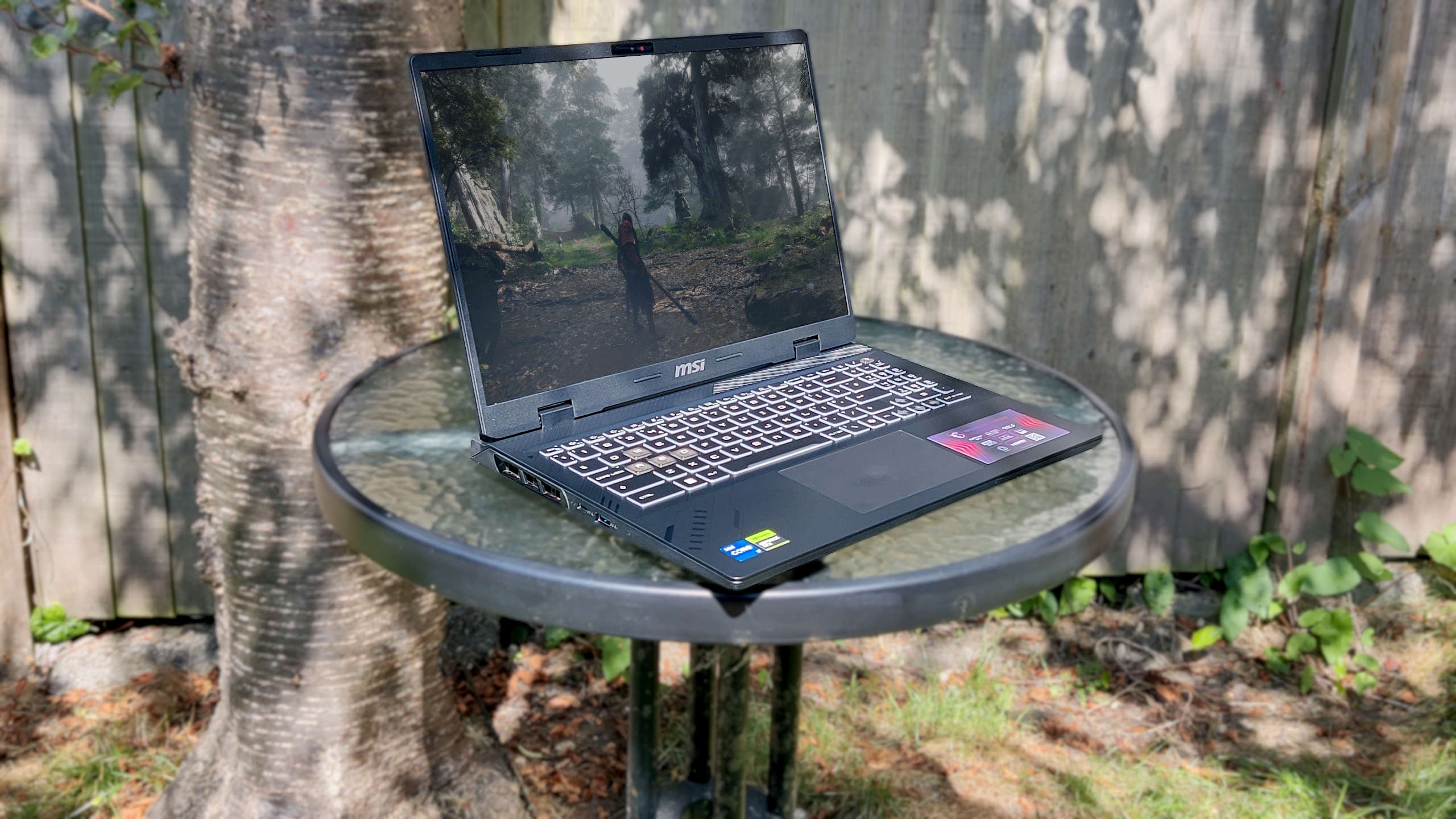
A chunky funky gaming laptop with high refresh and a lovely 16:10 panel.
Bearing in mind that the MSI Crosshair 16 HX’s RTX 4060 sits at the low end of Nvidia’s current generation of portable GPUs, you might be wondering how it can justify a £1,600/$1,750 price tag. The answer is “with difficulty”. There are a few reasons this gaming laptop might actually be worth considering at that price, not least the magic of a high-wattage GPU, but can it live up to the competition?
The MSI Crosshair 16 is not a subtle looking machine, at all. It’s chunky and a little bit funky, with a cyberpunk-style engraved design on the back, chamfers around the keyboard, hatching above it, and translucent WASD keys that shine through showing the mechanism underneath. Those keys forgo the pudding top design of the others, and while they’re not specifically unattractive, I would have appreciated a black legend on them since the white is a little difficult to see.
I appreciate the Crosshair’s keyboard layout, though, which pushes the numpad aside in favour of the important bits. I’ve ended up pressing FN a lot instead of the left arrow due to the placement of the directionals, but it’s far nicer to type on than a lot of squished gaming laptop keyboards I’ve tested.
The keypress also feels closer to a low profile mechanical key switch than your average membrane, with good pop to the actuation. The only real problem I’ve had with typing or playing on it is the sharp edge on the front. It makes it a little awkward if you’re sitting lower than the laptop. Otherwise it’s a relatively curvy machine compared to something like the Gigabyte Aorus 17X with its super-sharp aesthetic.
(Image credit: Future)
Model: Crosshair HX D14VFKG-002UK
CPU: Intel Core i7 14700HX
GPU: Nvidia RTX 4060 (140 W)
RAM: 16 GB (2 x 8 GB) DDR5-5600
SSD: 1TB NVMe PCIe Gen4 (WD PC SN560)
Screen: 16-inch | 2560 x 1600 (16:10)
Refresh rate: 240 Hz
OS: Windows 11 Home
Weight: 2.5 kg | 5.5 lb
Dimensions: 359 x 266.4 x 27.9mm | 14.1 x 10.4 x 1in
Price: £1,600 | $1,750 (closest spec)
Looks aside, it all feels very sturdy. Opening and closing the lid there’s hardly any shake, and I love that the screen sits slightly forward as the bit protruding behind it makes for a good handle when you want to shuffle into a different room without closing the lid. Despite being heavy, it still feels supremely portable. The 76 minute gaming battery life lets it down a little in that respect, but it’s still 20+ minutes more game time than others in its weight class.
While RTX 4060 gaming laptops are common as muck, ones that go up to 1440p are a little more rare, let alone a spicy 16:10 aspect ratio at 2560 x 1600 pixels—objectively the best aspect ratio according to our Dave. The reason being that the RTX 4060 is generally better suited to 1080p gaming.
Pit the MSI Crosshair 16 HX against lower wattage RTX 4060 machines with 1080p panels and it’ll outdo them nine times out of ten in the GPU-centered benchies. That 140 W GPU lets it push the envelope as to what you can achieve with low-end, current-gen Nvidia graphics. And although that means it runs a little hotter due to the extra power under the hood, it’s pretty good at dissipating that heat without sounding like it’s taking off.
Compare it to something of a more identical spec, price and panel like the Legion Pro 5i Gen 9, and it’s clear where MSI concentrated with the Crosshair. It might not match the kind of frame rates that the Legion pumps out, but it’s a much more balanced machine. A better bandwidth on the RAM and higher refresh rate for the same price would make any hot blooded gamer lean toward the MSI.
The problem is that, even when gaming in 1080p the Crosshair still can’t make the most of the high refresh rate. And while the MSI Crosshair still performs admirably, even in its native resolution, there’s a feeling that the 240 Hz refresh rate panel you’ve paid extra for is a little wasted.
(Image credit: Future)
(Image credit: Future)
(Image credit: Future)
(Image credit: Future)
(Image credit: Future)
✅ You want to play RPGs in middling res on the fly: Supremely portable and great for playing open world games at a steady frame rate, the Crosshair delivers for RP gamers.
✅ You don’t mind uninstalling a bit of bloatware: From Norton antivirus, to Arc in-game overlay, GOG and Battlenet, you might have to do a purge when you first open the lid.
❌ You’re a competitive gamer: You’ll likely be wasting the refresh rate at any resolution, and gaming at 1080p all the time is going to make you wish you hadn’t splurged on those excess pixels.
❌ You live in the US: The closest spec I could find for folk in the US is the Monster Hunter version, which adds another $150 for more (lower speed) RAM, and some pretty decorations. Probably not worth it unless you’re a massive fan of the series.
For a few hundred less, you can bag yourself a Gigabyte G6X that often outperforms the Crosshair at 1080p, even with its 105 W GPU and a last-gen Intel CPU backing it up. Sure, the battery life isn’t anything to write home about, but at least you aren’t paying extra for a wasted refresh rate. But then, if you want to play games in a higher resolution you don’t have that option at all without plugging in one of the best gaming monitors.
At the end of the day, the MSI Crosshair 16 HX is a joy to use, bar an initial session of uninstalling bloatware. The speakers are a little tinny, and the edge is a little sharp but these are all very tolerable qualms. And while it really shines in productivity and CPU-heavy tasks with its 14th gen Intel processor, and reaches over 100 fps in plenty of games, its major imbalance comes with throwing too much speed at a laptop that’s ostensibly competitive, but really is better suited for RPG heads.
If you just want a steady 60 fps to see you through at 1440p+, or see more of your Excel spreadsheet between gaming sessions with a taller panel, the MSI Crosshair 16 HX might be worth a punt. But what you don’t need is to pay extra for a 240 Hz panel meant for competitive gaming that your GPU can’t make the most of.






